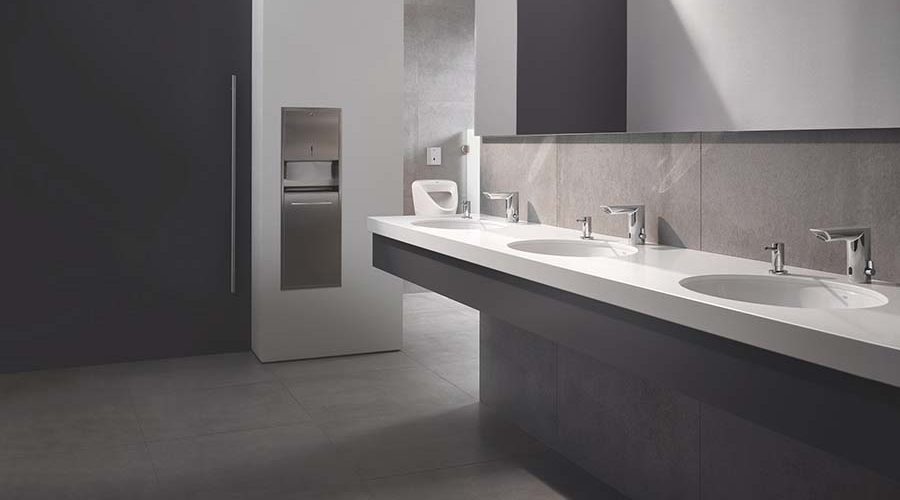Here, Elina Enqvist-Twomey, Category Manager at GROHE UK, shares a series of solutions for public washrooms and kitchen facilities, some hygiene hot spots in public buildings.
Grohe
While products that optimise hygiene have been commonplace in the public building sector for some time, this year hygiene has become a permanent and essential fixture in the interiors and design landscape like never before, and the demand for high-quality, hygiene-focused products in these spaces has risen significantly in order to ensure the best possible solutions are in place to protect public health, both in the face of the crisis and when a new form of normality resumes. At a time when the pandemic has pushed the everyday necessity of hand-washing into the spotlight, it is not surprising that builders, designers and specifiers in the public sector are seeking solutions that optimise hygiene and instil confidence and reassurance in end-users as they go about their everyday lives. While hygiene has jumped the ranks in terms of priority over recent months, it is likely to have longevity and a long-lasting impact on the public building sector.
Infrared taps
Infrared technology is a leading go-to hygienic solution in public buildings, primarily seen in washrooms with touchless taps and automatic flushing. The technology works by the infrared sensor registering when the user’s hands are approaching and automatically activating the flow of water. If the sensor no longer detects presence, the water will automatically turn off. This means that infrared taps require no human contact with the tap itself unlike standard taps where germs from unclean hands could linger on tap handles and are, therefore, perfect for public bathrooms with high footfall.
Other benefits of some more innovative infrared taps include pre-set programmes that ensure temperature is optimised for both safety and hygiene and ease-of-use for older generations and those with limited mobility thanks to touch-free operation, making it possible to create a hygienic space while also taking steps to improve accessibility. Also, the very best of these products are equipped with features that ensure water only flows when it is being used and even have an additional water-saving aerator that limits water consumption considerably, reducing it by up to 70% in some cases, which increases the sustainability credentials for public buildings without compromising on convenience or design.
Shower toilets
Shower toilets are beginning to be more understood by the mass market and designers, builders and specifiers in the public sector are increasingly understanding their multi-faceted nature and the value of the benefits they can offer. Cleaning with water after using the toilet is an age-old tradition that is still popular in many parts of the world, however, shower toilets bring this natural form of cleansing into the technology, and more recently, hygiene-focused 21st century; using automation and app-connectivity to create a hands-free experience.
Product innovations at the forefront of this category are equipped with automatic flush functionality and precise motion sensors which prompt the lid to automatically open upon approaching and close when you leave. A personalised cleansing experience can also be made possible via a smartphone app or remote control. Users can select their preferred temperature, spray pattern, pressure and much more. For example, GROHE’s Sensia Arena benefits from ion technology known as PlasmaCluster, which releases positive and negative ions into even the farthest hard-to-reach corners of the toilet bowl and in the air around the toilet, to inactivate bacteria. Meanwhile, an automatic odour extraction system is integrated into the toilet system to ensure the ambient air remains free from unpleasant odours. These state-of-the-art hygiene functions are particularly beneficial when shower toilets are used in public spaces with increased footfall. They help to maintain superior hygiene standards between each use to supplement routine cleaning protocols carried out by staff.
Hands-free kitchen taps
The kitchen is an integral and high-traffic area in many public buildings including schools, local Government, hospitals and emergency services and it is therefore just as important to prioritise the specification of products that optimise hygiene here as it is within bathrooms. Standard kitchen mixer taps are evolving; many models are doing away with the kitchen lever and opting for alternative modes of operation that reduce the need for direct contact with the tap’s surface. One of the latest ways of thinking is to replace the tap lever with a button at the end of the spout that can easily be pushed with the wrist, forearm or elbow to activate water flow. Not only does this method prevent the risk of cross-contamination from daily touch and usage but also when preparing food, especially
raw produce.
Health and hygiene are set to play a key role in defining the way public buildings are designed in the coming years, and product designs that use advanced technologies to meet this demand will likely continue to become a staple of the modern build.













